

Paragraph Writing in 1st and 2nd Grade - The Brown Bag Teacher. Just a few months ago we welcomed our first-grade friends and they were able to write a few words and if we were lucky, a complete sentence.

Since August we have worked oh-so-hard to develop interesting stories, taught our friends with how-to writing, and written letters to our favorite authors. Then comes the Spring and it’s time to embark on paragraph writing. One of the three main writing strands for 1st grade, our six-year old friends are expected to be able to introduce a topic, give and explain a detail, and then, wrap-up their thinking. In summary, 1st graders should be able to independently write a cohesive paragraph by the end of the year. So, the question is – how do we get our friends there?
Exposing Students to High Quality Paragraphs Writing inform/explain pieces in writing couples well with our nonfiction text unit in reading. Personalizing charts to foster intention and independence. Atelier d'écriture - Poésie. Les ateliers d'écriture au primaire à la CSDM. Vivre les ateliers d'écriture. Mettre en place les ateliers d’écriture n’est pas le chemin le plus facile, mais certainement le plus efficace.

Dans les derniers mois, plusieurs enseignants ont instauré les ateliers d’écriture en classe et nous confirment qu’ils ne reviendraient pas en arrière. Ateliers d’écriture au premier cycle. Un levier pour développer la compétence à écrire! Français Primaire » Les ateliers d’écriture. Séquence ateliers écriture et lecture. La classe de Madame Valérie: Comment faire? Toute leur vie, les élèves seront amenés à lire des marches à suivre ou encore à en expliquer.
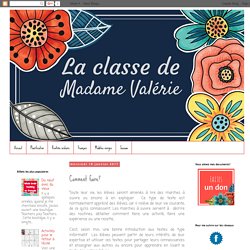
Ce type de texte est normalement apprécié des élèves, car il relève de leur vie courante, de ce qu'ils connaissent. Les marches à suivre servent à : décrire des routines, détailler comment faire une activité, faire une expérience ou une recette... C'est, selon moi, une bonne introduction aux textes de type informatif. Les élèves peuvent partir de leurs intérêts, de leur expertise et utiliser ces textes pour partager leurs connaissances et enseigner aux autres ou encore pour apprendre en lisant le texte des autres élèves. De plus, s'ils veulent éventuellement arriver à comprendre les étapes pour monter un meuble Ikéa, ou encore comment monter un barbecue, aussi bien les préparer dès maintenant! La plupart des textes de ce type utilisent des verbes à l'impératif. L'allumeur de réverbères. Un après-midi d’hiver 1974.

Dehors, il fait noir. Dedans, il fait silence. Nous sommes une centaine d’étudiants dans la grande salle d’étude du Collège de Montréal. Conferring with Writers is Like Coaching Skiers: Strength ID and Enhancement. Many years ago, one of my first jobs was as a ski instructor at a local ski resort.
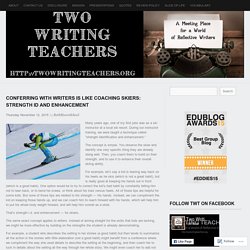
During our instructor training, we were taught a technique called “strength identification and enhancement.” The concept is simple. You observe the skier and identify one very specific thing they are already doing well. Then, you coach them to build on their strength, and to use it to enhance their overall skiing ability. For example, let’s say a kid is leaning way back on his heels as he skis (which is not a great habit), but is really good at keeping his hands out in front (which is a good habit).
That’s strength i.d. and enhancement — for skiers. The same exact concept applies to writers. When we support something that a student is doing well (or at least hinting at), we can aim to: I often keep a little cheat sheet right next to me as I confer, to remind me not to skimp on the compliment. Like this: Like Loading... Related. Best Mentor Texts for Narrative Writing in Grades K-2. Do you use the Teachers College Reading and Writing Project Units of Study?
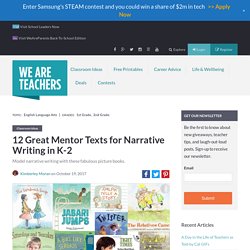
Not sure? You might call it the Lucy Calkins Writing Program. Punctuation Stickers: A Fun Punctuation Activity - Better Than Homework. I’m a writer, so punctuation comes naturally.
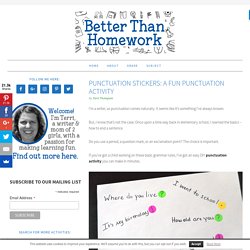
It seems like it’s something I’ve always known. Calaméo - Publications de documents interactifs en ligne. Creating Classroom Environments: Paper Choices. Every summer, my mom would take us kids school shopping at a local department store.
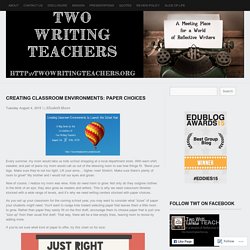
With each shirt, sweater, and pair of jeans my mom would call us out of the dressing room to see how things fit. “Bend your legs. Make sure they’re not too tight. Lift your arms… higher, now! Stretch. Now of course, I realize my mom was wise. As you set up your classroom for the coming school year, you may want to consider what “sizes” of paper your students might need. If you’re not sure what kind of paper to offer, try this chart on for size: * You can find all these paper choices and others here. To organize all these paper choices, you will probably want to set up an organized “Writing Center” in your classroom that is easily accessible, and is designed for kids to access the materials on their own.
Clearly labeled baskets make this writing center (housed in what was once a closet, now with door removed) nice and neat. Let’s chat on Monday, August 10th at 8:30 p.m. A Short & Sweet Minilesson Formula. In this post, I’m going to share a handy strategy for planning short and sweet minilessons.
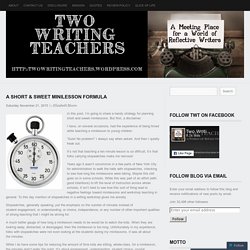
But first, a disclaimer. I have, on several occasions, had the experience of being timed while teaching a minilesson to young children. “Sure! No problem!” Your browser isn't supported.